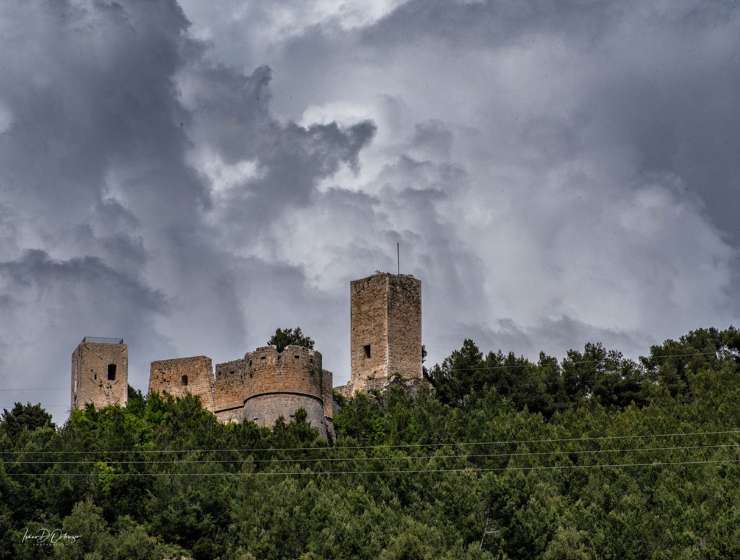About the etymology of the name Popoli, some argue that it derives from the Latin word "populus" (poplar], due to the abundance of this tree in the area. However, this is the simplest of theories. If this were to be accepted, many places in Italy where poplars grow everywhere should be called Popoli or Popòli!
Others, with more knowledge, derive it from the Latin "pauper" (poor). The name in the local dialect until the early 20th century was "Puòpere," so it's easy to derive this from the Latin "pauper." The Chronicon Casauriense (Book III, page XVI], representing the oldest written testimony regarding Popoli, attests to its name as Castrum pauperum. However, considering the transformation of "Puòpere" in the vernacular and what this fortified rock of the people would become from the Middle Ages to the late 19th century, we cannot ignore the word "Popoli" as an aggregation of many people who found themselves here for various reasons and common interests.
Much has been said and written about Popoli: its origins, the etymology of its name, the first settlements, its medieval development in the territory, its strategic importance, earning it the name "Key to the Three Abruzzos," its significance as a center for trade, both commercial and non-commercial, in the 19th century, its decline in the pre and post-war periods, and the partially successful attempts at revival in recent times. A writer of local history must always have clear goals in their work, and only by relying on irrefutable documents can they create a work with historical rigor. Everything else is speculation, conjecture, or personal opinion, which are subjective and leave much to be desired.
The first document that speaks of the area where our ancestors must have lived is Julius Caesar's "de bello civili." In chasing the Pompeian troops of Cnaeus Domitius Ahenobarbus, seeking refuge in Corfinium, he writes in Chapter XVI of Book I: "pons fluminis, quit erat ab oppido Corfinio milia passim circiter III" (a bridge of the river, which was about three miles from the town of Corfinium). This is a fixed point in our history: there was a bridge about four and a half kilometers from Corfinium. If there was a bridge in the Popoli area (considering the distance], someone must have built it and someone must have used it. We can, therefore, say that by 49 B.C., someone already lived in the area.
Two other important documents are the Chronicon Casauriense, already mentioned, and a postscript to the Vatican Code on the life of St. Pelinus. In them, the name Popoli appears for the first time concerning some property transactions of the castle between Bishop Tidolfo and the Casaurian abbots (1015-1016). For a millennium, we know nothing about our history, although hypotheses and/or conjectures have been argued, with more or less valid theories, albeit always in the realm of chance. Now we are in a more known and safer field: from the dawn of the first millennium to 1256, the history of the city and its ownership intertwines with various conflicting events that opposed the Bishop of Valva and the abbot of Casauria, with not always peaceful transitions of lordship from one to the other, interspersed with raids by bloodthirsty and unscrupulous adventurers or religiously motivated, given the authoritative "Christian" claimants.
In 1295, Charles of Anjou descended to Italy with a large group of knights, mostly of Provencal origin. Even though his adventures are well-known, only marginally interesting to our territories, his descent marked a fundamental historical change for Popoli. In 1269, as compensation for the help given, Charles of Anjou assigned the dominion of Popoli to one of his knights, Giacomo Cantelmo.
The Cantelmo family held the lordship of Popoli until 1749, when the last duke, Giuseppe, died in Spain (June 7, 1749). This family, lord for 480 years of the fief of Popoli, in the male line became extinct, and the fief passed to a woman, Camilla Cantelmo, wife of Leonardo Tocco, prince of Montemiletto. In 1656, Popoli had 2,226 inhabitants, who unfortunately were decimated, numbering 1,540, by the Manzonian plague. In 1749, with 1,300 inhabitants, the Cantelmo rule came to an end, the last of whom, Giuseppe XXIII, 16th Count and 9th Duke of Popoli, died in Spain without ever having been to Popoli, like his recent predecessors.
Being the geographic center of Abruzzo, at the crossroads of the only arteries that connected Naples, the capital of the Kingdom, with the provincial capitals, allowing passage from the Adriatic to Rome and vice versa, as well as from Naples to Florence (to avoid the Papal State], Popoli rose to a center of primary importance: whoever had dominion exercised the right to possess the keys to the three Abruzzos (the three provinces that administratively divided it: Ulteriore I, Ulteriore II, and Citeriore).
Consequently, it did not fail to develop what fate allowed most: commerce. With two weekly markets and four annual fairs, Popoli became the meeting point for the trade of the entire region, beginning to grow demographically in tandem. At the height of the Italian unification (1861], it already had 6,000 inhabitants when Castellamare Adriatica (Pescara) was a small fishing village and Sulmona had only a few hundred more inhabitants, eventually reaching a peak of 8,715 in 1947.





